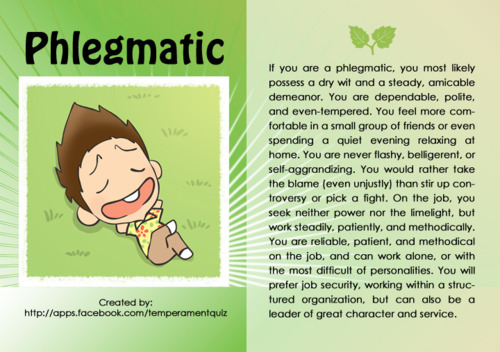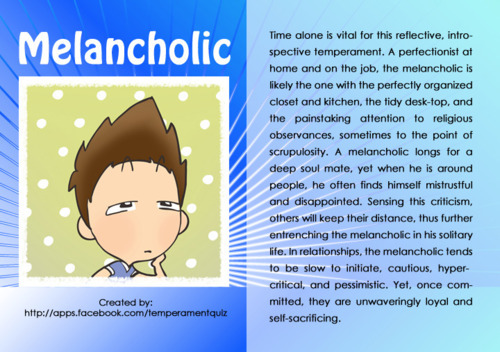WebQuest
different in personality
Introduction

Modern medical science has rejected the theories of the four temperaments, though their use persists as a metaphor within certain psychological fields.
| Classical | Element | Adler |
|---|---|---|
| Melancholic | Earth | Avoiding |
| Phlegmatic | Water | Getting |
| Sanguine | Air | Socially useful |
| Choleric | Fire | Ruling |
The four temperament types
Each of the four types of humors corresponded in ancient times to a different personality type. These were associated with a domination of various biological functions. Lievegoed suggested that the temperaments come to clearest manifestation in childhood, between approximately 6 and 14 years of age, after which they become subordinate (though still influential) factors in personality.
Sanguine
The sanguine temperament is traditionally associated with air. People with this temperament tend to be lively, sociable, carefree, talkative, and pleasure-seeking. They may be warm-hearted and optimistic. They can make new friends easily, be imaginative and artistic, and often have many ideas. They can be flighty and changeable; thus sanguine personalities may struggle with following tasks all the way through and be chronically late or forgetful. Pedagogically, they can be best reached through awakening their love for a subject and admiration of people.

Choleric
The choleric temperament is traditionally associated with fire. People with this temperament tend to be egocentric and extroverted. They may be excitable, impulsive, and restless, with reserves of aggression, energy, and/or passion, and try to instill that in others. They tend to be task-oriented people and are focused on getting a job done efficiently; their motto is usually "do it now." They can be ambitious, strong-willed and like to be in charge. They can show leadership, are good at planning, and are often practical and solution-oriented. They appreciate receiving respect and esteem for their work.Pedagogically, they can be best reached through mutual respect and appropriate challenges that recognize their capacities.
Melancholic
The melancholic temperament is traditionally associated with the element of earth. People with this temperament may appear serious, introverted, cautious or even suspicious. They can become preoccupied with the tragedy and cruelty in the world and are susceptible to depression and moodiness. They may be focused and conscientious. They often prefer to do things themselves, both to meet their own standards and because they are not inherently sociable. Pedagogically, they can be best met by awakening their sympathy for others and the suffering of the world.
Phlegmatic
The phlegmatic temperament is traditionally associated with water. People with this temperament may be inward and private, thoughtful, reasonable, calm, patient, caring, and tolerant. They tend to have a rich inner life, seek a quiet, peaceful atmosphere, and be content with themselves. They tend to be steadfast, consistent in their habits, and thus steady and faithful friends. Pedagogically, their interest is often awakened by experiencing others' interest in a subject.
People of this temperament may appear somewhat ponderous or clumsy. Their speech tends to be slow or appear hesitant.

The Public URL for this WebQuest:
http://zunal.com/webquest.php?w=260034
WebQuest Hits: 4,373
Save WebQuest as PDF
